Mohamed Sana
KVCompose: Efficient Structured KV Cache Compression with Composite Tokens
Sep 05, 2025Abstract:Large language models (LLMs) rely on key-value (KV) caches for efficient autoregressive decoding; however, cache size grows linearly with context length and model depth, becoming a major bottleneck in long-context inference. Prior KV cache compression methods either enforce rigid heuristics, disrupt tensor layouts with per-attention-head variability, or require specialized compute kernels. We propose a simple, yet effective, KV cache compression framework based on attention-guided, layer-adaptive composite tokens. Our method aggregates attention scores to estimate token importance, selects head-specific tokens independently, and aligns them into composite tokens that respect the uniform cache structure required by existing inference engines. A global allocation mechanism further adapts retention budgets across layers, assigning more capacity to layers with informative tokens. This approach achieves significant memory reduction while preserving accuracy, consistently outperforming prior structured and semi-structured methods. Crucially, our approach remains fully compatible with standard inference pipelines, offering a practical and scalable solution for efficient long-context LLM deployment.
Reasoning Language Models for Root Cause Analysis in 5G Wireless Networks
Jul 29, 2025Abstract:Root Cause Analysis (RCA) in mobile networks remains a challenging task due to the need for interpretability, domain expertise, and causal reasoning. In this work, we propose a lightweight framework that leverages Large Language Models (LLMs) for RCA. To do so, we introduce TeleLogs, a curated dataset of annotated troubleshooting problems designed to benchmark RCA capabilities. Our evaluation reveals that existing open-source reasoning LLMs struggle with these problems, underscoring the need for domain-specific adaptation. To address this issue, we propose a two-stage training methodology that combines supervised fine-tuning with reinforcement learning to improve the accuracy and reasoning quality of LLMs. The proposed approach fine-tunes a series of RCA models to integrate domain knowledge and generate structured, multi-step diagnostic explanations, improving both interpretability and effectiveness. Extensive experiments across multiple LLM sizes show significant performance gains over state-of-the-art reasoning and non-reasoning models, including strong generalization to randomized test variants. These results demonstrate the promise of domain-adapted, reasoning-enhanced LLMs for practical and explainable RCA in network operation and management.
TeleMath: A Benchmark for Large Language Models in Telecom Mathematical Problem Solving
Jun 12, 2025Abstract:The increasing adoption of artificial intelligence in telecommunications has raised interest in the capability of Large Language Models (LLMs) to address domain-specific, mathematically intensive tasks. Although recent advancements have improved the performance of LLMs in general mathematical reasoning, their effectiveness within specialized domains, such as signal processing, network optimization, and performance analysis, remains largely unexplored. To address this gap, we introduce TeleMath, the first benchmark dataset specifically designed to evaluate LLM performance in solving mathematical problems with numerical solutions in the telecommunications domain. Comprising 500 question-answer (QnA) pairs, TeleMath covers a wide spectrum of topics in the telecommunications field. This paper outlines the proposed QnAs generation pipeline, starting from a selected seed of problems crafted by Subject Matter Experts. The evaluation of a wide range of open-source LLMs reveals that best performance on TeleMath is achieved by recent models explicitly designed for mathematical or logical reasoning. In contrast, general-purpose models, even those with a large number of parameters, often struggle with these challenges. We have released the dataset and the evaluation code to ease result reproducibility and support future research.
Goal-Oriented Time-Series Forecasting: Foundation Framework Design
Apr 24, 2025Abstract:Traditional time-series forecasting often focuses only on minimizing prediction errors, ignoring the specific requirements of real-world applications that employ them. This paper presents a new training methodology, which allows a forecasting model to dynamically adjust its focus based on the importance of forecast ranges specified by the end application. Unlike previous methods that fix these ranges beforehand, our training approach breaks down predictions over the entire signal range into smaller segments, which are then dynamically weighted and combined to produce accurate forecasts. We tested our method on standard datasets, including a new dataset from wireless communication, and found that not only it improves prediction accuracy but also improves the performance of end application employing the forecasting model. This research provides a basis for creating forecasting systems that better connect prediction and decision-making in various practical applications.
Relative Representations of Latent Spaces enable Efficient Semantic Channel Equalization
Nov 29, 2024
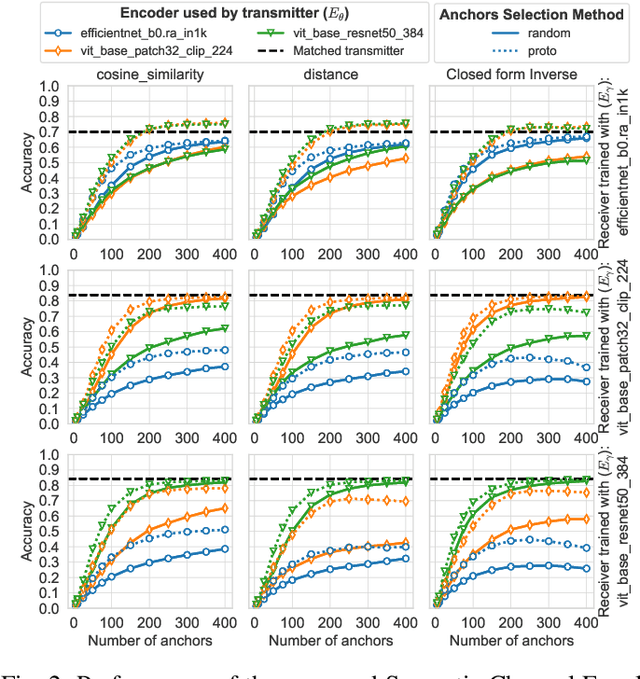
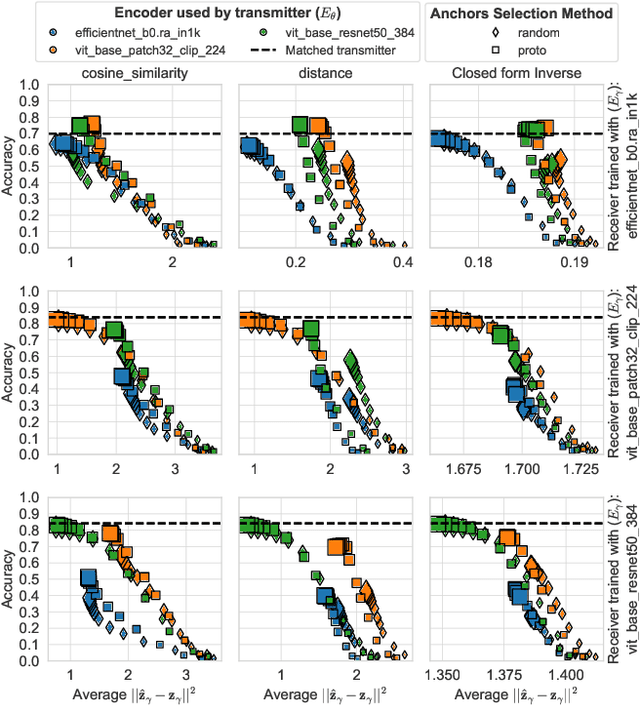
Abstract:In multi-user semantic communication, language mismatche poses a significant challenge when independently trained agents interact. We present a novel semantic equalization algorithm that enables communication between agents with different languages without additional retraining. Our algorithm is based on relative representations, a framework that enables different agents employing different neural network models to have unified representation. It proceeds by projecting the latent vectors of different models into a common space defined relative to a set of data samples called \textit{anchors}, whose number equals the dimension of the resulting space. A communication between different agents translates to a communication of semantic symbols sampled from this relative space. This approach, in addition to aligning the semantic representations of different agents, allows compressing the amount of information being exchanged, by appropriately selecting the number of anchors. Eventually, we introduce a novel anchor selection strategy, which advantageously determines prototypical anchors, capturing the most relevant information for the downstream task. Our numerical results show the effectiveness of the proposed approach allowing seamless communication between agents with radically different models, including differences in terms of neural network architecture and datasets used for initial training.
Early Acceptance Matching Game for User-Centric Clustering in Scalable Cell-free MIMO Networks
Jun 10, 2024



Abstract:The canonical setup is the primary approach adopted in cell-free multiple-input multiple-output (MIMO) networks, in which all access points (APs) jointly serve every user equipment (UE). This approach is not scalable in terms of computational complexity and fronthaul signaling becoming impractical in large networks. This work adopts a user-centric approach, a scalable alternative in which only a set of preferred APs jointly serve a UE. Forming the optimal cluster of APs for each UE is a challenging task, especially, when it needs to be dynamically adjusted to meet the quality of service (QoS) requirements of the UE. This complexity is even exacerbated when considering the constrained fronthaul capacity of the UE and the AP. We solve this problem with a novel many-to-many matching game. More specifically, we devise an early acceptance matching algorithm, which immediately admits or rejects UEs based on their requests and available radio resources. The proposed solution significantly reduces the fronthaul signaling while satisfying the maximum of UEs in terms of requested QoS compared to state-of-the-art approaches.
Soft Partitioning of Latent Space for Semantic Channel Equalization
Jun 04, 2024



Abstract:Semantic channel equalization has emerged as a solution to address language mismatch in multi-user semantic communications. This approach aims to align the latent spaces of an encoder and a decoder which were not jointly trained and it relies on a partition of the semantic (latent) space into atoms based on the the semantic meaning. In this work we explore the role of the semantic space partition in scenarios where the task structure involves a one-to-many mapping between the semantic space and the action space. In such scenarios, partitioning based on hard inference results results in loss of information which degrades the equalization performance. We propose a soft criterion to derive the atoms of the partition which leverages the soft decoder's output and offers a more comprehensive understanding of the semantic space's structure. Through empirical validation, we demonstrate that soft partitioning yields a more descriptive and regular partition of the space, consequently enhancing the performance of the equalization algorithm.
Latent Space Alignment for Semantic Channel Equalization
May 22, 2024

Abstract:We relax the constraint of a shared language between agents in a semantic and goal-oriented communication system to explore the effect of language mismatch in distributed task solving. We propose a mathematical framework, which provides a modelling and a measure of the semantic distortion introduced in the communication when agents use distinct languages. We then propose a new approach to semantic channel equalization with proven effectiveness through numerical evaluations.
Cooperative Sensing of Side Lobes Interference for mmWave Blockages Localization and Mapping
May 14, 2024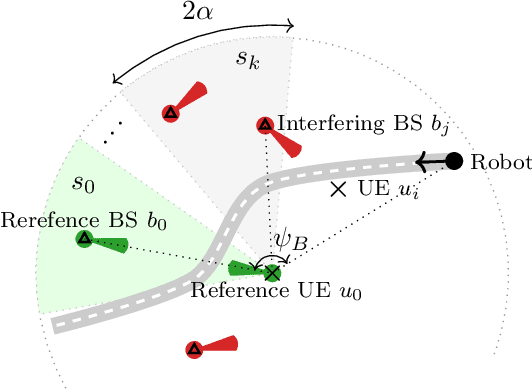
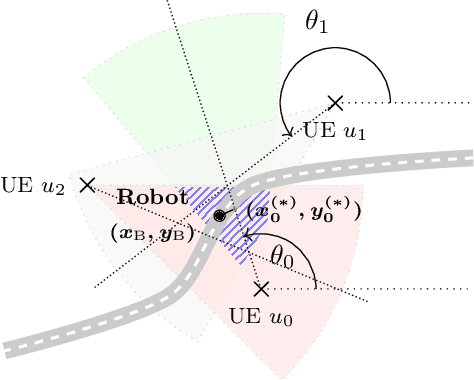
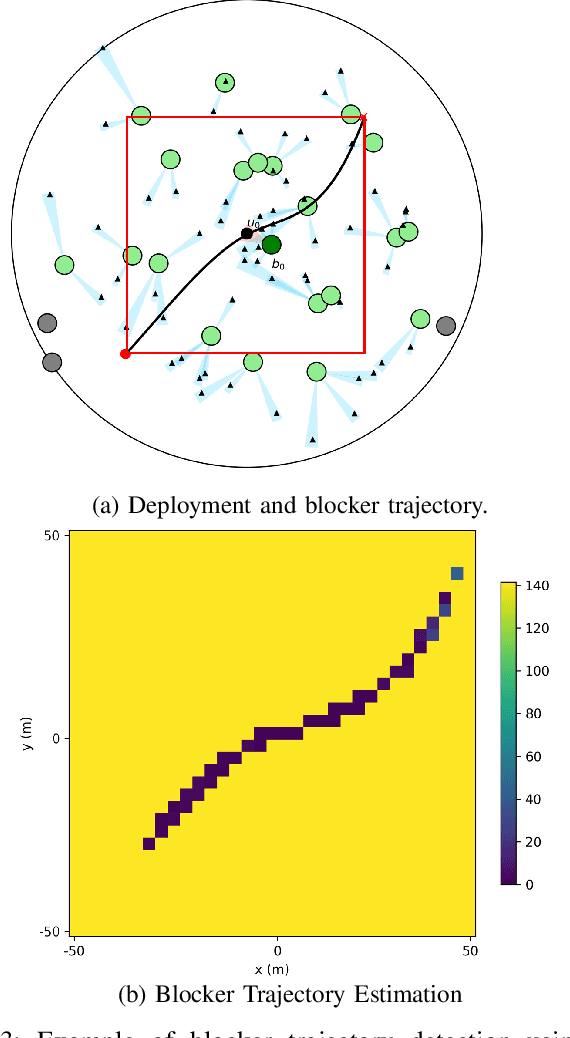
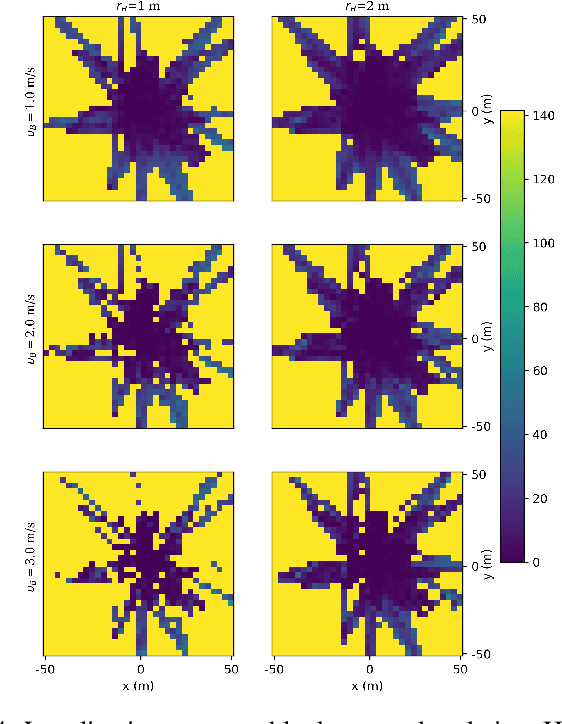
Abstract:Radio localization and sensing are anticipated to play a crucial role in enhancing radio resource management in future networks. In this work, we focus on millimeter-wave communications, which are highly vulnerable to blockages, leading to severe attenuation and performance degradation. In a previous work, we proposed a novel mechanism that senses the radio environment to estimate the angular position of a moving blocker with respect to the sensing node. Building upon this foundation, this paper investigates the benefits of cooperation between different entities in the network by sharing sensed data to jointly locate the moving blocker while mapping the interference profile to probe the radio environment. Numerical evaluations demonstrate that cooperative sensing can achieve a more precise location estimation of the blocker as it further allows accurate estimation of its distance rather than its relative angular position only, leading to effective assessment of the blocker direction, trajectory and possibly, its speed, and size.
Distributed Intelligent Integrated Sensing and Communications: The 6G-DISAC Approach
Feb 28, 2024Abstract:This paper introduces the concept of Distributed Intelligent integrated Sensing and Communications (DISAC), which expands the capabilities of Integrated Sensing and Communications (ISAC) towards distributed architectures. Additionally, the DISAC framework integrates novel waveform design with new semantic and goal-oriented communication paradigms, enabling ISAC technologies to transition from traditional data fusion to the semantic composition of diverse sensed and shared information. This progress facilitates large-scale, energy-efficient support for high-precision spatial-temporal processing, optimizing ISAC resource utilization, and enabling effective multi-modal sensing performance. Addressing key challenges such as efficient data management and connect-compute resource utilization, 6G- DISAC stands to revolutionize applications in diverse sectors including transportation, healthcare, and industrial automation. Our study encapsulates the project vision, methodologies, and potential impact, marking a significant stride towards a more connected and intelligent world.
 Add to Chrome
Add to Chrome Add to Firefox
Add to Firefox Add to Edge
Add to Edge